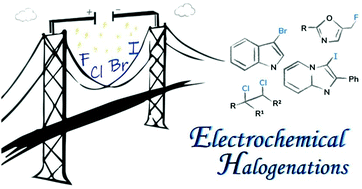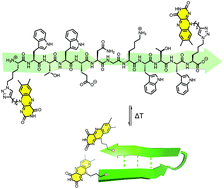Themed collection Synthetic electrochemistry

Introduction to synthetic electrochemistry: new tricks for an old discipline
Guest Editors Kevin Lam, Shelley D. Minteer and Darren L. Poole introduce the Organic & Biomolecular Chemistry themed issue on synthetic electrochemistry.

Org. Biomol. Chem., 2023,21, 221-222
https://doi.org/10.1039/D2OB90163C
Electrosynthetic C–F bond cleavage
This review describes synthetically relevant electrochemically driven protocols for cleavage and subsequent functionalization of C–F bonds, including photoelectrochemical strategies.

Org. Biomol. Chem., 2022,20, 6707-6720
https://doi.org/10.1039/D2OB01080A
Electrocatalysis as a key strategy for the total synthesis of natural products
This review provides an overview of the total syntheses of structurally intriguing natural products in which electrochemical processes play an important role as a key methodology.

Org. Biomol. Chem., 2022,20, 727-748
https://doi.org/10.1039/D1OB02115J
Recent progress on electrochemical synthesis involving carboxylic acids
Recent progress on sustainable electrochemical synthesis involving carboxylic acids was reviewed.

Org. Biomol. Chem., 2021,19, 5501-5520
https://doi.org/10.1039/D1OB00420D
Electrohalogenation of organic compounds
In this review we target sp, sp2 and sp3 carbon fluorination, chlorination, bromination and iodination reactions using electrolysis as a redox medium. Mechanistic insights and substrate reactivity are also discussed.

Org. Biomol. Chem., 2021,19, 2578-2602
https://doi.org/10.1039/D0OB02459G
Oxidative electro-organic synthesis of dimeric hexahydropyrrolo-[2,3-b]indole alkaloids involving PCET: total synthesis of (±)-folicanthine
An efficient electrochemical oxidation strategy for the total synthesis of (±)-folicanthine (1b), has been envisioned. Control experiments suggest that a PCET pathway involving stepwise ET-PT was involved in the key oxidative dimerization process.
![Graphical abstract: Oxidative electro-organic synthesis of dimeric hexahydropyrrolo-[2,3-b]indole alkaloids involving PCET: total synthesis of (±)-folicanthine](/en/Image/Get?imageInfo.ImageType=GA&imageInfo.ImageIdentifier.ManuscriptID=D1OB01463C&imageInfo.ImageIdentifier.Year=2021)
Org. Biomol. Chem., 2021,19, 9390-9395
https://doi.org/10.1039/D1OB01463C
Electrocatalytic hydrogenation of benzoic acids in a proton-exchange membrane reactor
The highly efficient chemoselective hydrogenation of benzoic acids to cyclohexanecarboxylic acids was carried out in a proton-exchange membrane reactor under mild conditions without hydrogenation of the carboxyl group.

Org. Biomol. Chem., 2021,19, 7363-7368
https://doi.org/10.1039/D1OB01197A
Facile access to foldable redox-active flavin-peptide conjugates
A convenient approach for the synthesis of foldable redox-active flavin peptide conjugates was established.

Org. Biomol. Chem., 2021,19, 4483-4486
https://doi.org/10.1039/D1OB00414J
Discovery of a tetraarylhydrazine catalyst for electrocatalytic synthesis of imidazo-fused N-heteroaromatic compounds
A tetraarylhydrazine-based redox catalyst has been discovered by serendipity through the electrochemical decomposition of a triarylamine. This catalyst is effective in promoting the electrosynthesis of imidazo-fused N-heteroaromatic compounds.

Org. Biomol. Chem., 2021,19, 8789-8793
https://doi.org/10.1039/D1OB01644J
Electrochemical bromofunctionalization of alkenes in a flow reactor
Electrochemical flow functionalization of alkenes is providing fast and easy access to dibromides or bromohydrins.

Org. Biomol. Chem., 2021,19, 6892-6896
https://doi.org/10.1039/D1OB01302E
Scalable electrochemical synthesis of diaryliodonium salts
The synthesis of cyclic and acyclic diaryliodonium salts by anodic oxidation of iodobiaryls and iodoarene/arene mixtures has been developed in a simple undivided electrolysis cell in MeCN–HFIP–TfOH without any added electrolyte salts.

Org. Biomol. Chem., 2021,19, 4706-4711
https://doi.org/10.1039/D1OB00457C
Electrochemical synthesis of sulfonated benzothiophenes using 2-alkynylthioanisoles and sodium sulfinates
Electrochemical sulfonylation/cyclization of 2-alkynylthioanisoles with sodium sulfinates was developed under catalyst-, external oxidant- and metal-free conditions.

Org. Biomol. Chem., 2021,19, 3844-3849
https://doi.org/10.1039/D1OB00079A
Continuous-flow electrosynthesis of selenium-substituted iminoisobenzofuran via oxidative cyclization of olefinic amides and diselenides
A novel method for the continuous synthesis of selenated iminoisobenzofurans by cyclization of olefinic amides with diselenides through electrochemical oxidation under metal-free and oxidant-free conditions has been developed.

Org. Biomol. Chem., 2021,19, 3207-3212
https://doi.org/10.1039/D1OB00236H
Peroxide- and transition metal-free electrochemical synthesis of α,β-epoxy ketones
A novel electrochemical method for the synthesis of α,β-epoxy ketones is reported.

Org. Biomol. Chem., 2021,19, 2481-2486
https://doi.org/10.1039/D0OB02444A
Chemoselective electrochemical reduction of nitroarenes with gaseous ammonia
Using graphite felt as electrodes and ammonia as a hydrogen source to reduce nitroarene to azoxyarene, azoarene, hydrazo, and aniline by tuning reaction conditions.

Org. Biomol. Chem., 2021,19, 2468-2472
https://doi.org/10.1039/D1OB00077B
About this collection
This collection, guest edited by Dr Kevin Lam (University of Greenwich), Professor Shelley Minteer (University of Utah) and Dr Darren Poole GlaxoSmithKline, aims to highlight some of the excellent research currently happening in the field of synthetic electrochemistry.
New articles will be added to the collection upon publication. Please return to this page frequently to see the collection grow.